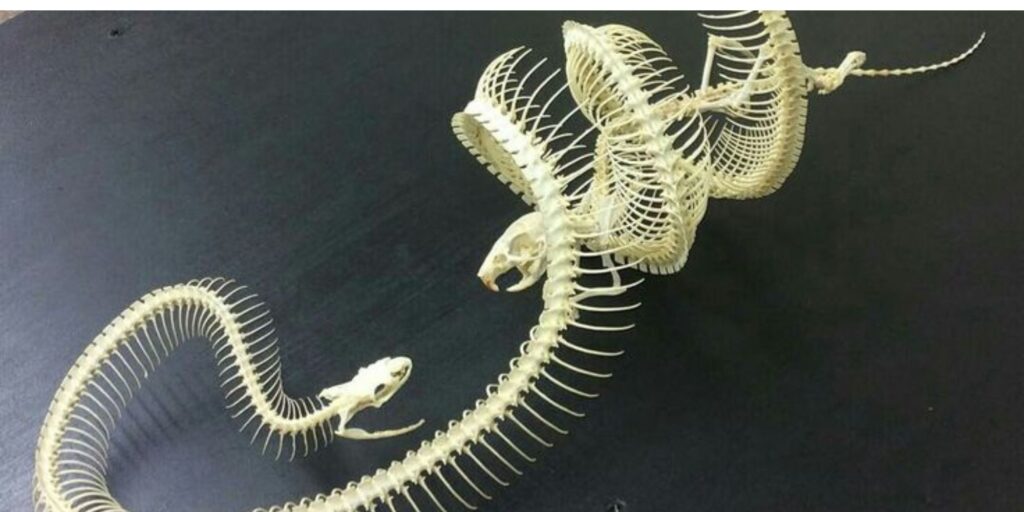Introduction
Have you ever wondered what lies beneath a snake’s sleek, scaly exterior? While these fascinating creatures can evoke fear and curiosity, their anatomy holds equally captivating secrets. Snake bones tell a story of evolution, adaptation, and survival. Unlike most animals, snakes possess an astonishing skeletal structure that allows them to thrive in diverse environments. Every aspect is designed for agility and efficiency, from their elongated spines to unique jaw mechanisms. Join us as we unravel the mysteries behind snake skeletons and explore how these incredible adaptations enable one of nature’s most enigmatic predators to navigate its world with grace and precision.
Unraveling the Mysteries: The Fascinating World of Snake Bones

The world of snake bones is a realm filled with intrigue and wonder. While many may think of snakes as simple creatures, their skeletal structures reveal a complex story. With over 200 vertebrae in some species, these elongated spines are the backbone of their movement and flexibility.
Each bone plays an essential role in how they navigate through various terrains. Unlike mammals, snakes lack limbs but have evolved other means to compensate for this absence. The vertebrae connect through joints that allow for incredible flexibility and agility, making them adept hunters.
One fascinating aspect is the presence of vestigial limbs in certain species. These remnants hint at evolutionary history, showcasing how these reptiles adapted over time to thrive without traditional legs.
Additionally, snake skulls exhibit remarkable modifications that enable unique feeding behaviors. Their jaw structure allows for the consumption of prey much larger than themselves—an adaptation largely attributed to their specialized dentition and flexible skull joints.
Exploring the Snake Skeleton
A snake skeleton is a remarkable structure that reveals much about these fascinating reptiles. Unlike many vertebrates, snakes possess elongated bodies and lack limbs, which makes their skeletal system unique. The entire body is supported by an intricate framework of bones designed for flexibility and mobility.
One striking feature of the snake’s anatomy is its vertebral column. Comprising hundreds of individual vertebrae, it allows them to glide smoothly through various terrains. Each vertebra connects seamlessly with its neighbor, creating a flexible backbone capable of bending in numerous directions.
Ribs are another essential component of the snake’s skeleton. These slender bones protect vital organs while enabling expansion during feeding—an adaptation crucial for consuming large prey items whole.
The absence of limbs may seem limiting at first glance; however, this design has propelled snakes into diverse habitats across the globe. Their specialized skeletal features make them masters of stealth and agility in pursuit or evasion from predators.
Vertebrae and Ribs

The snake skeleton is a marvel of evolution, particularly its vertebrae and ribs. Unlike mammals, snakes have an elongated spine that includes over 300 vertebrae. This incredible number allows flexibility and agility as they slither across various terrains.
Each vertebra connects through joints that enable smooth movement. The design helps them navigate tight spaces or climb trees with ease. It’s fascinating how this structure supports their unique locomotion methods, such as lateral undulation and sidewinding.
Ribs are another intriguing feature of snake anatomy. Snakes usually have a pair of ribs attached to each vertebra, protecting internal organs while allowing for expansion during feeding. Despite lacking limbs, these rib structures are crucial in maintaining the body’s integrity.
Interestingly, some species exhibit specialized adaptations within their ribcage. For instance, certain constrictor snakes modify their ribs to help immobilize prey more effectively during capture. This adaptability showcases the evolutionary ingenuity found in the world of snake bones.
Vestigial Limbs
Many people are surprised to learn that snakes possess vestigial limbs. These remnants of ancestors who once walked on legs provide an intriguing insight into evolutionary history. While modern snakes have adapted to a limbless lifestyle, these tiny structures hint at their distant relatives.
In some species, like pythons and boas, you can find small pelvic bones near the base of the tail. These structures may resemble miniaturized femurs or leg bones and serve no purpose in locomotion today. They stand as a testament to the snake’s fascinating journey through time.
Interestingly, these vestigial limbs can sometimes be seen externally as small spurs protruding from either side of the body. Though they might not be active in the movement, they contribute to mating rituals and displays during courtship seasons.
The presence of these limb remnants raises questions about adaptation and survival strategies in different environments. As snakes evolved to thrive without limbs, those once vital appendages transformed into mere echoes of their lineage’s past.
Joints of the Snake Skull
The joints of a snake skull are remarkable in their design. Unlike mammals, snakes have highly flexible skulls that allow them to consume prey much larger than themselves. This flexibility is due to the unique arrangement of bones and joints within the skull.
One fascinating feature is the presence of several movable joints between the upper jaw and lower ja
w. These joints enable a snake to unhinge its mouth, creating an impressive gape for swallowing large prey. Such adaptations are essential for survival, allowing these reptiles to take advantage of various food sources.
Additionally, many species exhibit specialized cranial sutures that facilitate rapid movements during strikes or defensive behavior. The mobility granted by these structures helps ensure they can react quickly to threats or opportunities alike.
Each joint plays a crucial role in balancing strength with agility. This intricate skeletal system not only supports feeding but also contributes significantly to snakes’ efficient navigation of their environments.
Understanding Snake Dentition
Snake dentition is a captivating aspect of their anatomy. Unlike mammals, snakes have evolved unique tooth structures that aid their feeding habits. Their teeth are primarily designed for grasping and holding onto prey rather than chewing.
Most snakes possess curved fangs that allow them to inject venom into their victims. These specialized teeth can retract, making it easier for the snake to strike without obstruction. Interestingly, not all snake species are venomous; some rely on constriction or swallowing their prey whole.
In addition to fangs, many snakes have rows of smaller teeth lining their jaws. These help grip slippery prey as it is swallowed alive or whole. The arrangement ensures that once something is caught, escape becomes nearly impossible.
Another intriguing feature is the replacement of teeth throughout a snake’s life. As older teeth wear down or break off, new ones grow in behind them—a continuous cycle that effectively supports their predatory lifestyle.
Snake Bones :Delving into the Taxonomic Key of Skull Modifications

The skull of a snake is not merely for protection; it’s an intricate structure that serves various functions. Taxonomically, these modifications can indicate evolutionary adaptations, helping us understand how different species thrive in their environments. Each alteration tells a story about survival and predation.
For instance, some snakes have larger or more elongated skulls to accommodate powerful jaws. This adaptation allows them to consume prey much larger than their head size would suggest. Others might feature flattened skulls suited for burrowing lifestyles or streamlined forms ideal for swift movement through grasslands.
Another fascinating aspect is the variation in tooth structures across species. Some snakes possess fangs designed specifically for injecting venom into prey, while others may have blunt teeth suitable for gripping slippery animals like fish. These dental adaptations highlight the diverse feeding strategies present in the snake world.
Studying these taxonomic keys reveals relationships among species and offers insight into their ecological roles. The complexity of snake skull modifications enriches our understanding of biodiversity within this unique group of reptiles.
Snake Bones :Further Resources and References
For those intrigued by the captivating world of snake bones, a wealth of resources is available to further their understanding. Various scientific journals and books delve deep into herpetology, providing insights into the anatomy and physiology of reptiles.
The “Journal of Herpetology” often studies various aspects of snake biology, including skeletal structures. For more hands-on learning, consider visiting local natural history museums, which may have exhibits highlighting snake skeletons.
Online platforms like the Smithsonian National Museum of Natural History host virtual exhibits where you can explore detailed images and descriptions of different species’ bones. Academic websites also offer taxonomic keys that can help identify specific skull modifications across diverse snake families.



